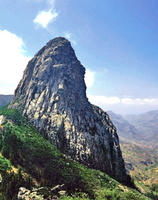You are in: Europe -> Spain -> Garajonay National Park, and traditional search or Image Gallery will yield results of this site only
Garajonay National Park
| Site number: | 380 |
|
| Type of site: | Natural | |
| Date: | - | |
| Date of Inscription: | 1986 | |
| Location: | Europe, Spain, Island of La Gomera, Province of Santa Cruz de Tenerife, Canary Islands | |
Up to 75 images are shown here. Click on each for more details or on Image Gallery for more images.
| Description: | The park is located in the middle of the La Gomera Island in the Canary Islands archipelago; some 70% of its area is covered with Laurel forest. Its springs and plentiful streams assure flourishing vegetation not unlike that of the Tertiary, which, thanks to climatic changes, has for the most part vanished from southern Europe. --WHMNet paraphrase from the description at WHC Site, where additional information is available. | |
| Garajonay National Park (Spanish: Parque nacional de Garajonay) is located in the center and north of the island of La Gomera, one of the Canary Islands. It was declared a national park in 1981 and a World Heritage Site by UNESCO in 1986. It occupies 15 square miles (40 square km) and it extends into each of the municipalities on the island. The park provides the best example of laurisilva, a humid subtropical forest that in the Tertiary covered almost all of Europe. It is also found on the Azores and the Madeira Islands. Laurus azorica, known as Azores Laurel, or by the Portuguese names Louro, Loureiro, Louro-da-terra, and Louro-de-cheiro, can be found in the park, as well as Laurus canariensis, known as Canary Laurel. The forests are made up of laurel-leaved evergreen hardwood trees, reaching up to 40 meters in height. Many of the species are endemic to the islands, and harbor a rich biota of understory plants, invertebrates, and birds and bats, including a number of endemic species. Two species of reptile, Gallotia gomerana (Gomeran lizard) and Chalcides viridanus (Gomeran skink), can be found. Amphibians include the stripeless tree frog, Hyla meridionalis. The park is renowned as one of the best places to observe the two Canarian endemic pigeons, Laurel Pigeon (Columba junoniae) and Bolle's Pigeon (Columba bollii).The peak and park are named after the doomed Guanche lovers Gara and Jonay, whose story evokes those of Romeo and Juliet and Hero and Leander. Gara was a princess of Agulo on La Gomera. During the festival of Beñesmén, it was the custom of unmarried girls of Agulo to gaze at their reflections in the waters of Chorros del Epina. If the water was clear, they would find a husband; if muddy, some misfortune would befall them. --Wikipedia. Text is available under the Creative Commons Attribution-ShareAlike License. | ||
| Source: | http://whc.unesco.org/en/list/380 | |
| Reference: | 1. UNESCO World Heritage Center, Site Page. | |












